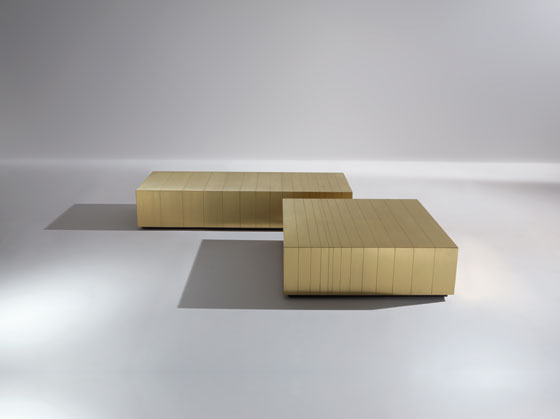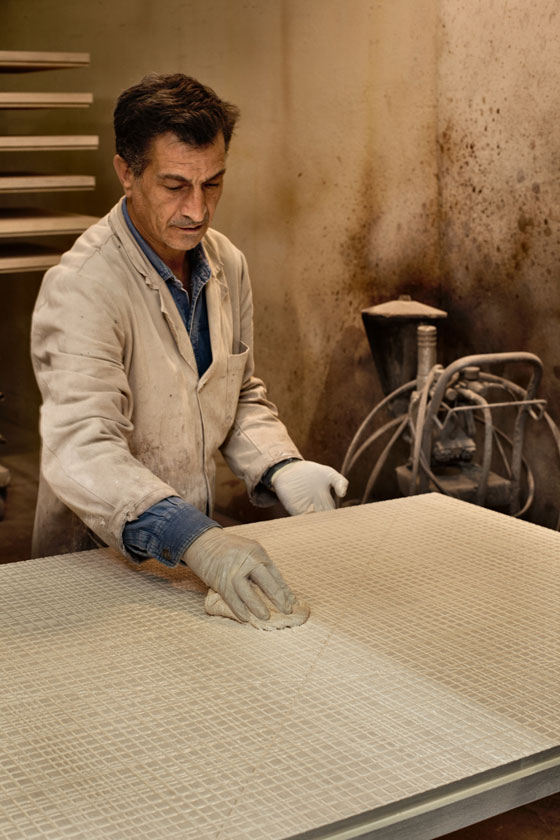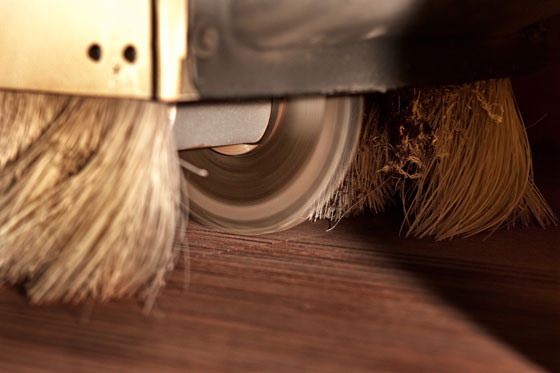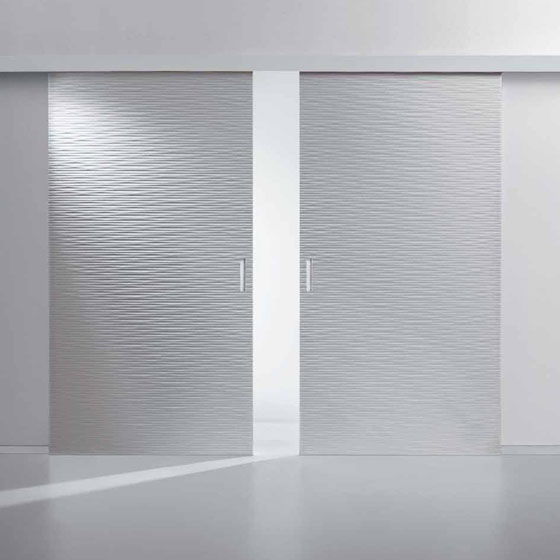Laurameroni: Industrialised Craftsmanship
Texte par Alex Bradley
London, Royaume-Uni
05.10.15
Embracing innovation in production technology while delivering exquisite hand-finishing, LAURAMERONI strives to give its clients something truly unique.
Hand-finishing by Brianza craftsman is a key step in the production of each Laurameroni piece
Do you live in a city? If so, you belong to the 54 per cent of the world’s population that currently do. I live in London and, like all great cities, it can get pretty noisy, with over 7 million residents, commuters and visitors going about their lives. For most people, this is part and parcel of what makes the city such a vibrant place to be.
This September saw London get even noisier and more vibrant with the arrival of the 12th edition of the London Design Festival. Just as London is crowded, the furniture sector is a crowded market, too, with many established and new brands looking to make some positive noise. Among the youngsters is LAURAMERONI, an Italian brand founded in 2000, which exhibited at 100% Design for the first time.
The Decor panels use CNC blades to cut three-dimensional textures into the surface
Founder and owner Mr. Massimo Maggioni shared some of his founding principles for the brand. From an early age, he says, he was fascinated by Brianza, an area 14km north of Milan and by the ability of its craftsmen.
‘“Over time, this craftsmanship has evolved and developed into industrial production. I wanted to invite designers to rediscover and exploit the unique skills of our master craftsmen.’” As a result LAURAMERONI sits between an industrial company and a local craftsman. ‘We use the quality, precision and engineering of industrialised manufacture with the fine details of a craftsman,’ explains Maggioni.
Flexibility and customisation
The industrialised approach of LAURAMERONI allows them to offer a flexible product catalogue, which has three core lines. Firstly ‘Art’, a line of limited-production intarsia (wood-inlayed) furniture. Secondly the ‘Design’ collection, which includes freestanding units, such as sideboards, tables and consoles. Finally, the ‘Architecture’ products, such as doors and wall panels.
Each collection can be customised to suite the specific needs of an architect, interior designer or private client. ‘“We can change the dimensions, material and colours, so we can make a special product for them.’”For example the Decor wood panelling – which is hand-finished following the creation of three-dimensional textures that are profiled by a computer numerical control (CNC) blade. These can then be specified as doors or panels that are made to measure for any room; from large commercial builds to private apartments.
A commercial office centre project in Bolzano, Italy, with customised Decor wall panels and sliding doors

A commercial office centre project in Bolzano, Italy, with customised Decor wall panels and sliding doors
×A private House in Munich, Germany, with Decor panels customised to clad the entire space
The Onda and Bamboo lines of doors and wood panels are also achieved by a combination of hand-finishing and CNC wood work. Onda is distinguished by irregularly shaped recesses that create a pleasing play of light and shade. The Bamboo collection is constructed with a series of channels of different sizes cut across the surface of the panel, each time creating different designs.
The introduction of bars, lacquered in a variety of colours, makes a number of visual combinations possible.
Surface design
All LAURAMERONI products leverage technological production innovations and the manual skill of Brianza craftsmen. A tangible product characteristic that results from this approach is evident in the surface of each product. As Maggioni states, ‘We strive to bring the design to the surface, as most of the time the design is considered to be the shape of the product [not the surface]. When you try to move the design to the surface of the product, you need more advanced techniques and hand-finishing. Most companies cannot reproduce products designed in this way. We try to make something more unique.’”
Onda sliding doors with irregular-shaped recesses that create a pleasing play of light and shade
An exemplary ‘surface design’ collection is Stars. Designed by Bartoli Design, it comprises a variety of brutally simple furniture forms, enlivened with metal panels that are divided into increasing and decreasing sequences of rectangles. Each rectangle has undergone hand-finishing to enhance the polished steel, natural brass, burnished copper or natural copper material options. The result is a surface design that is different every time, meaning no two products are the same, as the finishing process can result in a totally different tonal effect.
There is one problem with this fastidious approach to materiality, however, as Maggioni explains. ‘“Clients have told me that the images – which are shot by excellent photographers – do not do the product justice. You need to see it to believe it.’” This is especially true for the ‘Art’ collection, a range of limited pieces that use intarsia techniques – a woodworking process that utilises varied shapes, sizes and species of wood, fitted together to create a mosaic-like picture with an illusion of depth. It is an intricate technique that dates back to the 13th century.
The Bamboo collection is constructed with a series of differently sized channels. The introduction of bars lacquered in a variety of colours makes it possible to create a number of visual combinations

The Bamboo collection is constructed with a series of differently sized channels. The introduction of bars lacquered in a variety of colours makes it possible to create a number of visual combinations
×Acoustic design
Clearly, materials and innovative production techniques are the cornerstones of the LAURAMERONI design process, but what’s next? Partnering with Exhibo – a major player in the area of electro-acoustics as well as ambient acoustics and soundproofing since 1958 – LAURAMERONI has created Decor Acoustic.
Decor Acoustic is the result of a complete focus by LAURAMERONI on designing not just physical appearance but also acoustic experiences. Maggioni states that, ‘“The objective is to offer interior decorations that sound as good as they look, that are fit for purpose, that contribute to the improvement of our quality of life, our health and well-being, as well as our social behaviour and productivity.’”
A noisy environment, as mentioned, can make for a more vibrant one. However, according to the European Environment Agency – in their first noise-solution report – noise pollution is a major environmental health problem in Europe. Harmful levels of road traffic noise affect one in four people in the EU and increase health risks, ranging from sleepless nights to heart disease. Julian Treasure, the chair of the Sound Agency, a firm that advises businesses on how to use sound, suggests in a recent TED talk that architects should be more mindful of acoustics, ‘as sound affects us physiologically, psychologically, cognitively, and behaviourally, all the time.’
The Stars collection includes sideboards, console, coffee and dining tables, and is available in polished-steel, natural-brass, burnished-copper or natural-copper material options

The Stars collection includes sideboards, console, coffee and dining tables, and is available in polished-steel, natural-brass, burnished-copper or natural-copper material options
×According to the United Nations, 66 per cent of the world’s population will live in cities by 2050. That could add a dramatic 2.5 billion people to urban centres. From an architecture and interiors perspective, this will no doubt drive the need for more sophisticated and thoughtful furniture solutions.
It is heartening to see a furniture and interiors brand considering the bigger picture, whilst fastidiously exploring granular design details, such as materials and finish. Here’s hoping LAURAMERONI’s industrialised craftsmanship will continue to make all the right noises for years to come.










